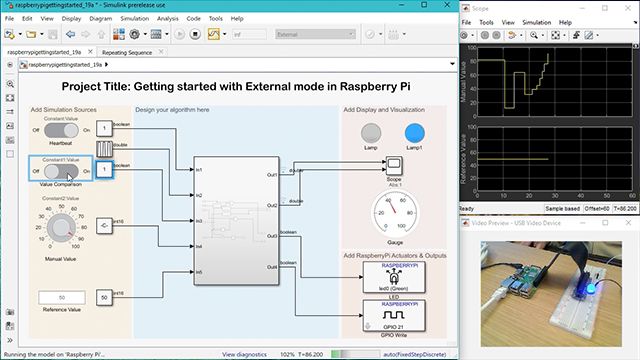
Interfacing MATLAB with external hardware, such as Arduino, Raspberry Pi, or other microcontrollers, opens up a world of possibilities for engineers, scientists, and hobbyists. This integration allows MATLAB users to interact with sensors, actuators, and other devices in real-time, enabling applications ranging from robotics and automation to data acquisition and IoT (Internet of Things). In this extensive guide, we will explore the process of interfacing MATLAB with external hardware, covering everything from setup and communication protocols to building practical projects and troubleshooting common issues.
Table of Contents
- Introduction to MATLAB and External Hardware Interface
- Hardware Options for Interfacing with MATLAB
- Setting Up MATLAB for Hardware Integration
- Communication Protocols and Interfaces
- Basic Input and Output Operations
- Sensor Data Acquisition and Processing
- Actuator Control and Automation
- Real-time Communication and Feedback
- Building Practical Projects and Applications
- Advanced Topics in Hardware Integration
- Troubleshooting and Debugging
- Best Practices and Tips
- Case Studies and Examples
- Conclusion
1. Introduction to MATLAB and External Hardware Interface
MATLAB’s versatility extends beyond numerical analysis and data processing; it offers powerful tools for interacting with external hardware. By interfacing MATLAB with hardware platforms like Arduino or Raspberry Pi, users can leverage MATLAB’s computational capabilities to control and monitor physical devices in real-time.
2. Hardware Options for Interfacing with MATLAB
There are various hardware options available for interfacing with MATLAB, including:
- Arduino: A popular microcontroller platform with a vast ecosystem of sensors, actuators, and shields.
- Raspberry Pi: A credit-card-sized computer capable of running MATLAB and interfacing with a wide range of peripherals.
- NI (National Instruments) hardware: Data acquisition devices and instrument control modules supported by MATLAB’s Data Acquisition Toolbox.
3. Setting Up MATLAB for Hardware Integration
Before interfacing MATLAB with external hardware, users need to set up their MATLAB environment and install any necessary support packages or toolboxes. MATLAB provides support packages for Arduino and Raspberry Pi, which can be installed using the Add-On Explorer.
4. Communication Protocols and Interfaces
Communication between MATLAB and external hardware typically involves serial communication, Ethernet/Wi-Fi communication, or GPIO (General Purpose Input/Output) pins. MATLAB supports various communication protocols, including UART, I2C, SPI, TCP/IP, and UDP, allowing seamless integration with different hardware platforms.
5. Basic Input and Output Operations
Once the hardware is set up and communication is established, users can perform basic input and output operations from MATLAB. This includes reading sensor data, sending commands to actuators, and monitoring the status of digital pins.
% Example of reading sensor data from Arduino
a = arduino();
sensor_pin = 'A0';
sensor_value = readVoltage(a, sensor_pin);
6. Sensor Data Acquisition and Processing
MATLAB provides powerful tools for acquiring, processing, and analyzing sensor data. Users can apply signal processing techniques, such as filtering, smoothing, and feature extraction, to raw sensor data for extracting meaningful information.
% Example of signal processing for sensor data
filtered_data = smooth(sensor_data);
features = extractFeatures(filtered_data);
7. Actuator Control and Automation
Controlling actuators and devices from MATLAB allows users to automate tasks and perform real-time control. This could include controlling motors, LEDs, relays, or other output devices based on sensor readings or user inputs.
% Example of controlling a motor with Arduino
motor_pin = 'D9';
writeDigitalPin(a, motor_pin, 1); % Turn on the motor
8. Real-time Communication and Feedback
Real-time communication and feedback are essential for interactive applications and closed-loop control systems. MATLAB’s capabilities enable users to establish bidirectional communication between MATLAB and external hardware, allowing for real-time monitoring and control.
% Example of real-time feedback control
target_temperature = 25; % Set target temperature
while true
current_temperature = readTemperature(sensor);
if current_temperature < target_temperature
turnOnHeater();
else
turnOffHeater();
end
end
9. Building Practical Projects and Applications
Interfacing MATLAB with external hardware opens up endless possibilities for building practical projects and applications. This could include:
- Home automation systems for controlling lights, appliances, and HVAC systems.
- Robotics projects for controlling robot arms, drones, or mobile robots.
- Environmental monitoring systems for measuring temperature, humidity, and air quality.
- IoT applications for collecting and analyzing data from connected sensors and devices.
% Example of building a home automation system
10. Advanced Topics in Hardware Integration
Advanced topics in hardware integration with MATLAB include:
- Multi-device communication and synchronization.
- Integration with cloud platforms for remote monitoring and control.
- Implementing closed-loop control systems and feedback mechanisms.
- Machine learning and AI applications for predictive maintenance and anomaly detection.
11. Troubleshooting and Debugging
When interfacing MATLAB with external hardware, users may encounter issues related to communication errors, hardware compatibility, or software configuration. MATLAB provides tools and resources for troubleshooting and debugging, including diagnostic messages, error logs, and online support forums.
12. Best Practices and Tips
To ensure successful hardware integration with MATLAB, it’s essential to follow best practices such as:
- Properly documenting hardware connections and configurations.
- Testing hardware and communication protocols before deploying applications.
- Implementing error handling and fallback mechanisms for robustness.
- Keeping hardware and software components up-to-date with the latest firmware and drivers.
13. Case Studies and Examples
Case studies and examples demonstrate real-world applications of hardware integration with MATLAB, showcasing innovative projects and solutions developed by MATLAB users across different industries and domains.
14. Conclusion
Interfacing MATLAB with external hardware opens up exciting opportunities for building interactive applications, automation systems, and IoT solutions. By leveraging MATLAB’s computational power and hardware integration capabilities, users can create innovative projects and solve complex problems across various domains. Whether you’re a hobbyist experimenting with Arduino, a researcher building a data acquisition system, or an engineer developing a control system, MATLAB provides the tools and resources you need to succeed in interfacing with external hardware and bringing your ideas to life.